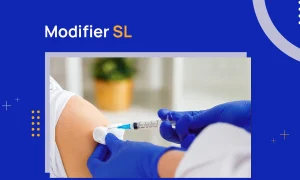Did you know that approximately 40 million magnetic resonance imaging (MRI) scans are performed annually in the U.S. alone? It is a non-invasive diagnostic procedure that uses powerful magnetic fields and radio waves to generate detailed pictures of soft tissues. These images assist physicians in confirming diagnoses such as debilitating sciatica.
However, billing for these non-invasive procedures, such as the one represented by CPT code 72148, has its specific challenges. Thus, this comprehensive guide will help you navigate the documentation and payment rules for this essential radiology procedure.
So, if you are a radiologist or run a radiology center, we recommend you read this guide till the end!
CPT Code 72148 – Description
CPT code 72148 covers the MRI of the lumbar spinal canal and its contents without the use of a contrast agent. For procedures that use a contrast agent, there is another more specific code available, i.e., CPT 72149.
For the unversed, the lumbar spinal canal is the lower section of the back that comprises the five lumbar vertebrae (L1-L5) and the lumbosacral junction.
Appropriate Use Cases for CPT Code 72148
The following are a few real-world clinical scenarios related to CPT code 72148:
Sciatica and Radiculopathy Evaluation
Picture a 43-year-old female patient who visits her primary care physician. She has been experiencing severe, radiating pain (sciatica) over the past few weeks. The pain moves from her buttocks down her left leg to her foot. Moreover, she complains about experiencing a tingling sensation and numbness in the same direction.
Initially, the physician tried conservative treatment. However, it has been six weeks, and the symptoms have persisted. The healthcare practitioner suspects a herniated nucleus pulposus (also known as a slipped disc). Thus, he orders an MRI of the lumbar spine without contrast (CPT code 72148).
Known Spondylolisthesis Monitoring
Consider a 51-year-old male patient with a history of spondylolisthesis in the lumbar region. For context, it is a condition in which one spinal vertebra slips out of place and presses on another vertebra.
The patient visits the healthcare provider for a follow-up. He reports that the pain has worsened over the past few weeks, and he is experiencing difficulty walking.
Thus, the provider orders an MRI of the lumbar spine without contrast (CPT code 72148). The aim is to monitor the degree of vertebral slippage.
Chronic Lower Back Pain Assessment
Imagine a 63-year-old female patient with a history of chronic lower back pain. The pain worsens when she stands or walks. The physician performs a physical examination that hints towards a structural problem, such as spinal stenosis or severe degenerative disc disease.
Thus, the physician orders an MRI of the lumbar spine without contrast (CPT code 72148). The findings help him determine the severity of facet joint arthritis and assess the diameter of the spinal canal.
Modifiers to Append with CPT Code 72148
Listed below are some of the applicable modifiers related to CPT 72148:
Modifier 26
Are you the physician who interpreted the MRI images of the lumbar spine and prepared the report? If yes, report CPT code 72148 with modifier 26. It highlights to the payer that you have only performed the professional component of the service.
Modifier 51
What happens when the same physician performs multiple diagnostic imaging procedures for the same patient in the same session? You append modifier 51 to the secondary procedure.
For instance, a 50-year-old female patient visits her primary care physician. She reports a new onset of sciatica and persistent headaches. Thus, the physician orders two diagnostic imaging services. Therese includes:
- CPT code 72141 – MRI for cervical spine without contrast
- CPT code 72148 – MRI for lumbar spine without contrast
Both of these procedural codes are subject to the multiple procedure payment reduction (MPPR) rule as imposed by the Centers for Medicare and Medicaid (CMS).
Thus, when you report these services, CMS will reimburse the primary service at a 100% rate. However, the reimbursement for secondary service will be reduced by 50% for the technical component and 5% for the professional component.
Modifier TC
Hospitals and radiology centers that own the equipment, resources, and supplies typically append this modifier while reporting for CPT code 72148. It indicates that you are billing only for the technical component of the MRI for the lumbar spine without contrast.
Reimbursement Guidelines for CPT Code 72148
Discussed below are the essential billing and reimbursement guidelines related to the MRI scan of the lumbar spine.
Demonstrate Medical Necessity
Reimbursement from payers heavily relies on establishing the medical necessity of the rendered service. That is, if a billed procedure is deemed clinically unnecessary, it will result in claim denial.
Thus, you must ensure that the service covered under CPT code 72148 is medically necessary. Some of the clinical indications for performing an MRI of the lumbar spinal canal are listed below:
- A progressive, persistent, or severe radiculopathy or sciatica that is unresponsive to conservative treatment.
- Assessment of vertebral slippage with associated new or worsening nerve symptoms.
- Clinical findings suggest a nerve root impingement or a slipped disc.
- Clinical suspicion of a spinal tumor, abscess, or osteomyelitis when initial X-rays are inconclusive.
- Evaluation of suspected spinal stenosis.
- Unexplained or worsening motor weakness in the lower extremities.
- Urgent evaluation for acute bilateral leg weakness, saddle anesthesia, or bowel/bladder dysfunction.
Ensure Detailed Documentation
Your documentation must be comprehensive and include the following:
- Clearly specify the levels examined during the MRI, e.g., L1-L5.
- State the specific pulse sequences performed, e.g., STIR, T1, and T2 weighted images.
- Describe in detail all relevant pathology and anatomy. These include findings related to the cord and nerve roots, the degree of central or foraminal stenosis, and the location and size of disc herniations.
- Concisely conclude the diagnostic findings.
Append Appropriate Modifier
Note that CPT code 72148 is a global procedure. That is, it involves both the technical and professional components. Thus, if you want to bill for either one of the components, you need to append the relevant modifier: 26 (professional) and TC (technical).
Another important modifier you need to know about is 51, which indicates that you performed multiple diagnostic imaging procedures in the same session.
Final Thoughts on CPT Code 72148
MRI is an optimal diagnostic tool that physicians often employ to acquire highly detailed images of a patient’s soft tissues. But it is an expensive procedure. Thus, payers may require you to obtain pre-authorization before rendering the service.
Besides, when it comes to billing for the MRI of the lumbar spinal canal without contrast, you must understand the specific reimbursement guidelines. We hope this guide will help you master billing for CPT code 72148. However, if you still struggle, feel free to outsource radiology billing services to NeuraBill.



